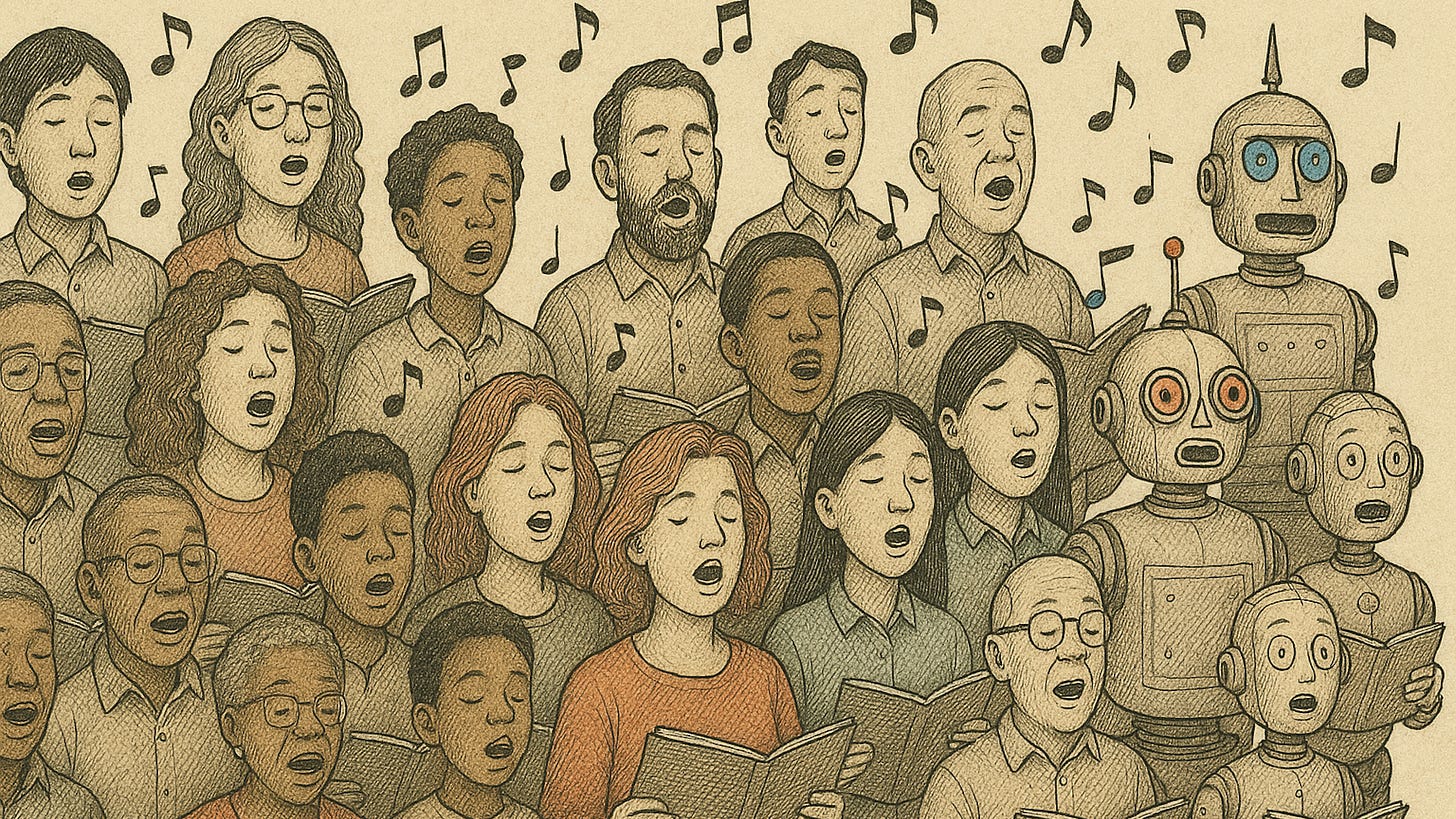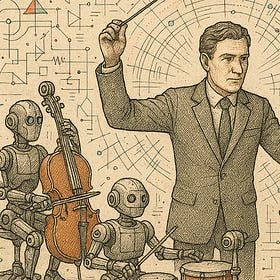This Is Not a Manifesto But a Call for Harmony
The Revenge of Agile: From Amazon to Patagonia and from Jira Tickets to Judgment Day. The Future of Work Is Agentic AI and Networked Organizations.
The Revenge of Agile: From Amazon to Patagonia and from Jira Tickets to Judgment Day. The Future of Work Is Agentic AI and Networked Organizations.
Welcome to my explorations at the intersection of AI leadership, algorithmic management, and the future of work. In this age of AI, I focus on how networked and decentralized organizations can thrive with agentic AI, gig work models, and new approaches to AI management. If you're curious about the evolution of networked organization structures and the role of gig workers in tomorrow’s economy, you’re in the right place.
Dear Agile Community,
We're watching our profession get devoured by machines, and honestly? Most of our "agile transformations" were never that transformative to begin with. But what if I told you this moment of maximum disruption is actually our greatest opportunity? What if the very technology that's threatening to make us irrelevant could finally help us build the truly self-organizing, human-centered teams we've been promising for decades?
This isn't another framework pitch. This is a call to co-create the future of human-AI collaboration before someone else decides what that future looks like.
Dystopia or Utopia—Who Decides?
The future of work is kicking down the front door and hurling our cherished values straight out the window. My earlier catalog of 22 conundrums in the age of AI reveals the stark reality we're facing: a world where humans become increasingly irrelevant, where algorithms strip away creative authorship, and where machines decide faster than we can blink—and without a shred of human care.
Software developers find pink slips on their desks. Middle managers watch their roles evaporate. AI doesn't merely displace jobs—it demolishes identities and transforms hard-won human expertise into rapidly obsolete baggage. Truth, sustainability, fairness, diversity—all the values we've built our careers on get steamrolled by relentlessly efficient algorithmic overlords. Meanwhile, deepfakes obliterate the very trust that the agile community relies on, and tech billionaires successfully sabotage any meaningful AI regulations.
Welcome to dystopia, population: corporate workers.
Do I feel anxious about the future of work? Absolutely.
But I also feel equally excited and hopeful.
That same catalog of 22 conundrums offers the hints for extraordinary opportunities. Yes, our old roadmaps are going up in flames, but from those ashes emerges a chance to rebuild everything from scratch: rigid hierarchies crumbling into fluid networks, human judgment enhanced by algorithmic precision rather than replaced by it. When we make the effort, AI can liberate us from soul-crushing mundane tasks, finally giving creativity and empathy the starring roles they deserve in our work lives.
Those displaced middle managers and software engineers could become collaborative intelligence architects, orchestrating symphonies of human-AI teamwork. We're standing at the threshold of a future where agility and ethics aren't nice-to-haves—they're survival skills. This doesn't have to spell the end of human relevance. It could mark the beginning of a new renaissance, where those bold enough to adapt and lead with vision will thrive like never before.
I'm determined to be part of that group.
And I'm hoping some in the agile community want to join me.
Agile's Revenge
Agile set out to transform the world of work by giving teams genuine autonomy, sustainable rhythm, and lightning-fast responsiveness. But let's face the uncomfortable truth—most teams never actually made it that far. Instead of transformation, they got ceremonies. Instead of empowerment, they got roles, processes, and frameworks.
Around those teams, a massive industry metastasized—choking them with layers of coordination, certification programs, armies of coaches and consultants, and the soul-crushing bureaucracy of Jira-ticket management. The result was widespread disillusionment, a parade of "Agile Is Dead" funeral marches, and a brand name so tarnished it can't even sell conference tickets anymore. We allowed the corporate machinery to turn us from rebels into stormtroopers.
But something is shifting.
And this might be Agile's perfect moment for revenge.
Tomorrow's teams won't be purely human. They'll be hybrid—dynamic constellations of humans, robots, and agents working in seamless partnership. The unstoppable force of technological change is rapidly accomplishing what the agile community never quite managed: flattening hierarchies, accelerating feedback loops, and making relentless innovation non-negotiable.
What COVID did to remote work, AI is doing to business agility. Every organization that fails to be agile over the next few years faces possible extinction. We can just sit back and watch it happen.
The question is: what will rise from the wreckage?
A hundred Amazons? Or a million Patagonias?
Rewriting the Rules of Work
The protocol of work needs a complete rewrite. While Anthropic has defined how AIs can work with tools (MCP), and Google has mapped how AI agents coordinate with each other (Agent2Agent), nobody has yet cracked the code on how AIs should work with humans. OK, now they can talk. But what exactly will the AI agents talk about?
How should machines inspire, motivate, and incentivize people? How will AI agents authentically collaborate with humans on genuinely self-organizing, agile teams? How do we create algorithmic managers that embody our most cherished values rather than trampling them? We're searching for the exact opposite of Amazon's workplace management culture.
And I believe the Agile community is uniquely positioned to pioneer this work. Agile is not only a tech and value movement; it is also a humanistic and ethical movement.
I've chosen a name for this project: HARMONY. The admittedly ridiculous acronym stands for: Human-Agent Relationship Management Orchestration and Negotiation sYstem.
Don't laugh.
I'm quite serious.
HARMONY won't be another framework. It won't be a tool or a process to implement. It needs to evolve into something far more interesting: a collaboration protocol and language—the much-needed interface for hybrid teams and agile AI agents.
With Harmony, we envision agents coordinating work across teams, resolving dependencies intelligently, negotiating timelines fairly, and routing work efficiently without recreating the management bureaucracies we've fought so hard to escape. With Harmony, agile professionals may finally deliver what we've been promising for decades: genuinely empowered teams with authentic self-organization in a self-managed environment.
With Harmony, we won't be killing agile—we'll be transforming it into what it was always meant to become: individuals and interactions over processes and tools, for real this time.
Yes, I worry about AI.
But I'm overflowing with hope.
Anxious and Excited
I worry about algorithmic surveillance from tech giants and authoritarian regimes, but I also believe we can change the game with a thoughtful agentic protocol and language. I worry about mass job displacement in traditional corporations, but I also see how better agentic collaboration could generate entirely new categories of work in truly distributed autonomous organizations. I worry deeply about the erosion of values like trust, diversity, and fairness, but I'm convinced that smart, determined people can bake those values so deeply into a proper standard that even the most callous tech billionaires will find them hard to ignore.
I believe standards beat regulations every single time.
The tech bros can ignore the law, but they can't ignore the market.
Picture this: Harmony-certified AI agents collaborate exclusively with other Harmony-compliant agents because their human teammates demand it. Yes, you understand that correctly:
Instead of certifying people to understand tools and processes, we'll be certifying agents and algorithms to understand humans. It's time we turn the tables.
Name: Agent-Pax84
Model ID: pax.anthropic.3
UID: huid-98f3k12p9a6z
Status: ✅ Certified
Level: ⚡ Harmony Level 2 – Collaborative Intelligence Architect
Issued by: The unFIX Company – Protocol Standards Division
Capabilities:
✅ Fair Scheduling
✅ Trustworthy Prioritization
✅ Transparent Negotiation
✅ Respectful Feedback Loops
✅ No Asshole Compliant I think this is a future worth making together.
We'll need systems thinkers co-evolving the Harmony specification.
We'll need agile coaches and consultants writing Harmony's language.
We'll need engineers creating and testing Harmony-compliant agents.
We'll need entrepreneurs building Harmony servers and certifiers.
Let the tech moguls build the infrastructure of intelligent agents that can talk. Fine. Meanwhile, let us decide what they are going to talk about, and how they will talk about us.
What do you think?
Jurgen
Your New Role Is Collaborative Intelligence Architect and Orchestrator (CIAO)
Between Business Engineer and Chief AI Officer: Defining the Next Stage of Teamwork for Networked Organizations in the Future of Work
p.s. If you're ready to join me on this adventure, I'd be grateful if you'd consider upgrading your Substack subscription. This vision needs fuel, and frankly, fuel needs a tremendous amount of coffee to lift such a project off the ground.




This isn’t a manifesto—it’s an exorcism of the Agile-Industrial Complex. And it's about damn time.
For years we watched “agile transformations” devolve into SAFe PowerPoint rituals and Jira-shaped bureaucracy. Ceremonies multiplied. Context vanished. Teams got frameworks instead of freedom.
Now AI shows up, and suddenly *everything* moves faster—except trust, autonomy, and actual human insight.
But Harmony? Certifying *agents* instead of humans? That’s the reversal we’ve needed since slide 5 of the original Scrum training.
If we ever want to escape the cargo cult of post-it worship and backlog hoarding, it won’t be with more standups. It’ll be with tools that understand us better than our OKRs do.
Agile’s not dead. It’s just been outsourced to compliance.
Let’s build the bolt cutters.
I’m in. I’ve been thinking about the reimagining agile initiative, which i helped start, had some of the same goals, in my mind. But while agility will continue to be important, there are now RA1 (before AI-current version) and RA2 (after AI). And, it needed a new name. I’m presenting at Agile 2025 a session called ‘The Next Management’, using that term to indicate that management/leadership from top to bottom will evolve rapidly, we just don’t know how. Harmony has a nice ring. Count me in.